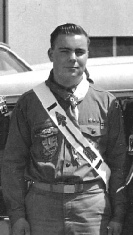





















ORDER OF THE ARROW HISTORY (as described in Wikipedia.com)
 The Order of the Arrow (OA) is the national honor society of the Boy Scouts of America (BSA). It uses American Indian-styled traditions and ceremonies to bestow recognition on scouts selected by their peers as those that best exemplifying the ideals of Scouting. Arrowmen as they are called wear a sash over their right shoulder to signify membership in the Order of the Arrow.
The Order of the Arrow (OA) is the national honor society of the Boy Scouts of America (BSA). It uses American Indian-styled traditions and ceremonies to bestow recognition on scouts selected by their peers as those that best exemplifying the ideals of Scouting. Arrowmen as they are called wear a sash over their right shoulder to signify membership in the Order of the Arrow.
The society was created in 1915 by E. Urner Goodman, with the assistance of Carroll A. Edson, as a means of reinforcing the Scout oath and the Scout Law. The goal was to establish these as lifelong guidelines, and to encourage continued participation in Scouting and camping. Influenced in part by camp traditions, college fraternities, and Indian folklore, the OA uses "safeguarded" symbols, handshakes, and ceremonies to impart a sense of community.
In 1915, E. Urner Goodman, was a newly hired field executive for the Philadelphia Council, and was assigned to serve as director of the council's summer camp at Treasure Island Scout Reservation on the Delaware River. He believed that the summer camp experience should do more than just teach proficiency in Scoutcraft skills; rather, the principles embodied in the Scout Oath and Scout Law should become realities in the lives of Scouts. Along with his assistant camp director, Carroll A. Edson, he started an experimental program, Wimachtendienk ("Brotherhood" in the Lenape language), to recognize those Scouts best exemplifying those traits as an example to their peers.
Goodman and Edson decided that a "camp fraternity" was the way to improve the summer camp experience and to keep the older boys coming back. In developing this program they borrowed from the traditions and practices of several other organizations. Edward Cave's Boy's Camp Book was consulted for the concept of a camp society that would perpetuate camp traditions. College fraternities were also influential for their concepts of brotherhood and rituals, and the idea of new members pledging themselves to the new organization. Ernest Thompson Seton's Woodcraft Indians program was also consulted for its use of American Indian lore to make the organization interesting and appealing to youth. Other influences include the Brotherhood of Andrew and Phillip, a Presbyterian church youth group with which Goodman had been involved as a young man, and Freemasonry. The traditions and rituals of the latter contributed more to the basic structure of the rituals than any other organization. In an interview with Edson during his later years, he recalled that the task of writing the first rituals of the society was assigned to an early member who was "a 32nd degree Mason." Familiar terms such as "lodge" and "obligation," were borrowed from Masonic practice, as were some ceremonial practices. Even the early national meeting was called a "Grand Lodge," thought to be a Masonic reference. Goodman became a Mason only after the OA was established.
They ultimately devised a program where troops chose, at the summer camp's conclusion, those boys from among their number who best exemplified the ideals of Scouting. Those elected were acknowledged as having displayed, in the eyes of their fellow Scouts, a spirit of unselfish service and brotherhood. Edson helped Goodman research the traditions and language of the Lenni Lenape—also known as the Delaware—who had once inhabited Treasure Island. The brotherhood of Scout honor campers with its American Indian overtones was a total success.
By 1921, Goodman had spoken to Scout leaders in surrounding states about the honor society resulting in a number of lodges being established by Scout councils in the northeastern United States. The name of the society was changed to Order of the Arrow, and in October 1921, Goodman convened the first national meeting of what was then called the "National Lodge of the Order of the Arrow" in Philadelphia—where Goodman was elected as Grand Chieftain.[8] Committees were organized to formulate a constitution, refine ceremonial rituals, devise insignia, and plan future development.
In the early 1920s, many Scout executives were skeptical of what they called "secret camp fraternities." By September 1922, opposition to the Order of the Arrow was such that a formal resolution opposing "camp fraternities" was proposed at a national meeting of Scout executives. Goodman argued against the motion: "Using the Scout ideals as our great objective", he said, a camp activity that will "further the advancement of those ideals" should not be suppressed. The motion was narrowly defeated, and the fledgling Order continued as an experimental program throughout the 1920's and 1930's. In 1931, there were OA lodges in seven percent of BSA councils nationwide. By 1948, about two-thirds of the BSA councils had established OA lodges. That year also marked the time when the OA was fully integrated as an official part of the Scouting program.
THE LODGE
The basic unit of the OA is the lodge, which is chartered to a local BSA council. The lodge chief is the elected youth leader, the lodge advisor is a BSA adult volunteer appointed by the Scout Executive, and the lodge staff advisor is the council Scout executive or his designated council professional Scouter. The lodge youth officers, consisting of the lodge chief, one or more vice chiefs, a secretary, and a treasurer are responsible for organizing and leading the various programs and activities of the lodge. Many lodges have standing committees responsible for ceremonies, service projects, publications, unit elections, camp promotions, and dance teams composed of youth members. Lodges can also divide into chapters, usually corresponding to districts within the council. The village or chapter is lead by the elected youth chapter chief, a volunteer adult is appointed as the adviser and the district executive is the professional (staff) adviser.
OAKLAND AND SAN FRANCISCO LODGES
The San Francisco Council was the first to organize an Order of the Arrow lodge for their council when the Royaneh Lodge was organized in 1944. The Oakland Area Council established a lodge in 1947 which was known as Machek N’Gult. When the two Scout councils merged in 1964 so did their respective Order of the Arrow lodges. The San Francisco Bay Area Council is supported by Achewon Nimat Lodge 282 of the Order of the Arrow.
